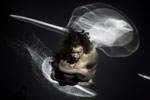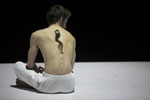NOTHING THERE - Or Do Dreams Go to Sleep during the Day?
The Symptoms, Hungary
Duration: 65 minutes
Director / Choreographer: Szabó Réka
Dancers: Dózsa Ákos, Góbi Rita, Nagy Andrea, Szász Dániel, Vadas Zsófia Tamara, Vass Imre
Dramaturge: Peer Krisztián
Interactive technology: MTA SZTAKI Media Technology Group
(Papp Gábor, Sárosi Anita, Vicsek Viktor)
Music
Composer: Márkos Albert
Sound: Németh Márton
Soprano: Kozma Orsolya
Mezzosoprano: Harcsa Veronika
Violoncello: Márkos Albert
Piano: Puskás Péter
Doublebass: Hock Ernő
Drums: G. Szabó Hunor
Light and space: Szirtes Attila
Costume: Nagy Fruzsina
Production executive: Paizs Dóra
Special thanks: Gideon Obarzanek
Co-production partners: Computer and Automation Research Institute of the Hungarian Academy of Sciences (MTA SZTAKI), Trafo House of Contemporary Arts
Supporters: OKM, NKA, Flórián Workshop, Artus, MU Theater, L1 Independent Dancers’ Partnership, Marland Kft, szinhaz.hu, tancelet.hu
Nothing There - Or Do Dreams Go to Sleep during the Day?
My dear senses, you have let me down. You too, my one and only imagination. I keep tweaking my own portrait, over and over again, and I bend the contours of everything and everyone. But does this make it the world according to me, once and for all? How does one look outside of here? And what if there’s nothing out there to look at? Is that just another thing that I project?
I want clothes to protect the outside world from me. For I have come to the conclusion that there are no miracles.
The central theme of the performance by The Symptoms is the clash between the reality principle and the truth principle. The anxiety generated by this conflict stays with us through our lives, poisoning our days in the guise of reality. It’s as if this paranoia were intended to force us to vest with meaning the random events of an ill-comprehended world and perceive the chaotic reality surrounding us as a subject-centric system that makes sense. However, this desperate attempt to ascribe meaning to the universe distorts our very perception, effectively preventing us from seeing things in the genuine light of their being. This is why the same thing will be seen by one person as something, and something entirely different by another.
The real-time video technology employed by this piece reacts to the position in space of a body in motion, as well as its shape, direction, and dynamics of movement, transforming the gestures of the six dancers into the projection of their anxieties and fantasies, and their web of relations into a mobile abstract painting.
The Symptoms
The Symptoms is a performance group consisting of dancers and actors, founded in 2002 by the Hungarian dancer and choreographer Réka Szabó.
The Symptoms occur in a variety of formats: from street actions to theatre performances, from free improvisations to choreographies with dance and real-time video technologies. Their performances are games with common issues: chance, dreams, identity, global warming, recycling - mixing and juxtaposing different languages from contemporary dance to pantomime, from poetry to science, all this with a symptomatic humour.
They are mainly performing in Budapest, but also in venues, streets and festivals all over Europe.
“Performed to thudding jazz, the piece plays out a waking dream shot through with bizarre terrors. Half-glimpsed tableaux reminiscent of David Lynch’s film Eraserhead morph into surreal ballroom sequences in swimsuits and spats that pay homage to Pina Bausch.
Vignettes of pain, fear and sadness swim dreamily against a lighting track of eye-popping strangeness. Extraordinary.”
Luke Jennings, The Guardian


